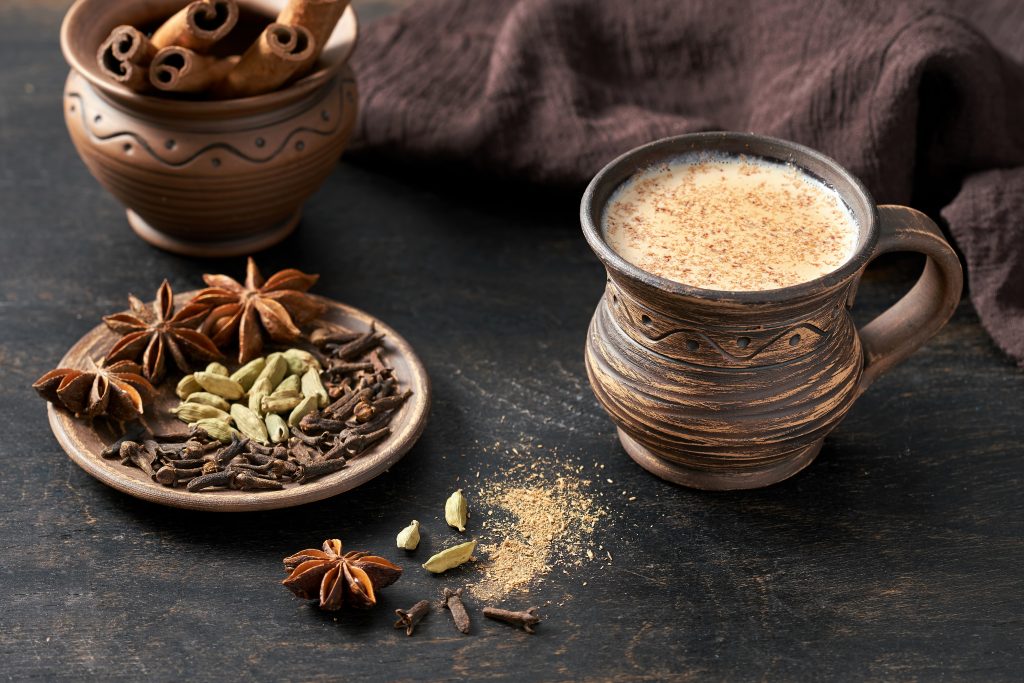
An Introduction to Masala Chai
The rising popularity of chai tea in western countries is described in this Beginners Guide, but did you know that it has been a crucial part of Indian society for over 5,000 years? According to legend, chai tea was originally created without any tea, milk, or sugar. Instead, it was an Ayurvedic elixir composed of hot water and spices. Ayurveda is a 5,000-year-old Indian healing method based on nature.
In the 1600s, the Chinese discovered black tea leaves and began exporting them.
Due to the British occupation of India, black tea leaves were grown there for export. Chai, which combines a strong, pungent mixture of spices, became a popular beverage. As a result, masala chai, a type of chai tea, is the term used in India. In Hindi, masala means ‘spiced’, or spice blend, hence chai masala refers to spiced tea.
A tea that is made with black tea, various spices (such as cardamom, cinnamon, peppercorns, cloves, and ginger), and milk is known as masala chai tea. Chai is renowned for its strong taste, so it is frequently sweetened with honey or sugar and combined with milk.
What spices are in Masala Chai?
Chai can be mixed with several spices, but these are the chai tea ingredients and spices in chai tea commonly used.
Cinnamon – Chai has numerous health advantages thanks to one ingredient: cinnamon. The cinnamon gives the tea a warm, slightly spicy flavor.
Ginger – Ginger has a sweet and spicy flavor. It also contains many health benefits. Ginger is essential in a good traditional masala chai.
Cardamom Powder or Cardamom Pods – Cardamom is the seeds of a plant related to ginger . Cardamom has a spicy, minty, and citrus taste.
Cloves – Because they are so warming, cloves enhance cinnamon and cardamom flavours by heightening their aromas. In addition, they have a strong aromatic flavour in their own right.
Black Pepper – Despite the fact that peppercorns are an important element in chai tea, thinking about them in tea may seem unconventional. The peppercorns give the tea a spicy and welcoming taste that blends well with the other components.
Fennel – Fennel in Chai has a sweet, licorice-like flavour thanks to fennel seed.
Star Anise – Those who want a stronger, more licorice-flavored chai can substitute fennel seeds with star anise.
Chai can be made in different ways.
The bold, full-bodied taste of black tea provides the foundation for chai tea, which is why it is used. You may use either tea bags or loose leaf tea. Crumble or pulverize your chosen spices. Add boiling water to your tea and spices and steep for about ten minutes.
Pour your tea into mugs and add milk if you wish. You can utilise any sort of milk, including dairy-free milk such as coconut, oat or almond milk, to make your tea. For sweetness, add sugar or honey to your taste.
Jaggery (also known as ‘Gur’ or ‘Panela’), produced from sugarcane or palm sap water evaporation is also a popular sweetener in India. This can be found both in a powdered Jaggery form, or whole Jaggery.
Chai Tea Benefits
The great spices that make up chai are what make it such a healthy drink. Chai was first used as an Ayurvedic health treatment to heal the body and the mind.
Chai May Help Reduce Cholesterol
According to scientific research, drinking black tea, the foundation of chai tea, can decrease cholesterol levels. Cinnamon, black pepper, and ginger, all present in chai, have also been shown to assist keeping bad cholesterol levels down.
Chai May Help in Reducing Inflammation
Inflammation is an adverse effect of many long-term illnesses including Alzheimer’s, diabetes, and multiple sclerosis. Chai may help decrease inflammation in the body, which would result in increased mobility and decreased or diminished instances of these diseases. Black tea, cardamom, cinnamon, and ginger are all capable of reducing inflammation.
Increased Blood Flow
Chai contains several spices that have been shown to boost blood flow, lower blood pressure, and decrease the chance of heart attack or stroke. Cinnamon, ginger, and black pepper are among them.
Having a healthy immune system is crucial to staying healthy.
During cold and flu season, chai is an excellent warming drink to enjoy because not only does it taste fantastic, it has been used for centuries to boost immune function in the body. Many of the spices found in chai tea have antibacterial and antiviral properties.
Scientists are sure to find more health benefits as they continue their studies, but these are just a few of the advantages of spiced chai tea.
Ways to Make Masala Chai
Homemade: Homemade chai tea is always the best chai. Using spices, or a blended masala is the original way to make masala chai. Here are some great pre-blended masalas for making homemake chai.
Whole Spice Masala Blends with Loose Leaf Black Tea
Chai Tea Bags
For a slightly faster cup of chai, pre-blended chai tea bags are available. Simply boil water, steep, add your milk and sweetener of choice and enjoy.
Chai Tea Concentrate
Chai concentrates are chai masala spices, brewed with tea and made into a concentrate. With this process, use the amount of concentrate to your taste preference, add choice of milk and sweetener. Some of these concentrates are already sweetened.
Masala Chai Powdered Blends
Chai powdered blends are another quick and convenient way of enjoying masala chai. Blend with water, your choice of milk and sweetener. These are convenient for travel as well.
Resources: Information on Cinnamon, Cardamom, and Ginger
